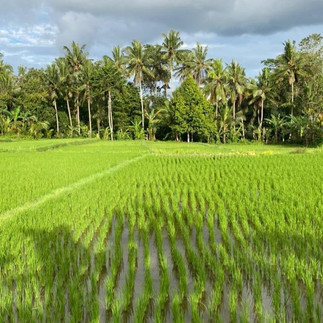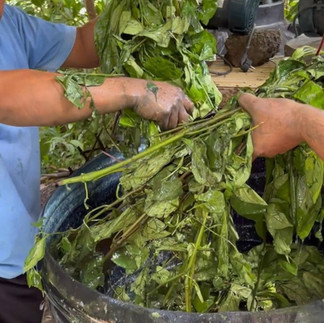Exploring the Vibrant World of Dye Gardens: the therapeutic process of designing with nature
- Kyle Palmer

- May 3, 2023
- 4 min read
Kyle Palmer chats with 2022 George Alexander Foundation Fellow Kiri Bowmer about her work in the dye garden.

How did you get into dye gardens? Were you a landscape architect first?
I got into plant dye during the COVID-19 lockdowns basically out of boredom - I was aware of a couple of inspirational natural dyers (Lucia LaFerme, Aboubakar Fofana) and turned to my backyard for inspiration. I am a Landscape Architect, and have been practicing for about 7 years now. I also come from a family of passionate gardeners, and some of my earliest memories are of plants - I guess it helped being eye-level with them when you’re small! Weirdly, there is very little overlap between gardening and Landscape Architecture - we are often mistaken as ‘gardeners’ or ‘landscapers’ - but the two don’t necessarily overlap. So it was interesting to me to realise that I had all of this knowledge about the use of plants that I wasn’t using in my Landscape Architecture work - e.g. aloe vera can treat burns, rosemary (Rosemarinus officinalis) can improve memory, oleander (Nerium oleander) (a common street tree in Europe) is incredibly poisonous - a weird fact to know watching people walk past, completely unaware of this.
How do you extract dye from plants?
It varies depending on the plant, but basically, you take either the roots, leaves or flowers of the dye plant and simmer this with water in order to extract the dye. It's worth noting, indigo is kind of a different beast entirely - it is biologically alive and needs to be ‘fed’ to be kept healthy. The indigo vat we were using in Indonesia (strobilanthes cusia) was fed tamarind, bananas and brown sugar (it had a sweet tooth - and it should taste sweet). Many cultures believe that indigo (both the plant and the colour) is medicine and has a soul or a lifeforce which is imbued on to whoever wears it. Some cultures will sing to their dye vats to keep them healthy. The whole process of indigo dyeing is fairly magic - a process of ‘working with the living’.
Above: pictures from Kiri's Fellowship trip to Umajati Retreat, run by 'Threads of Life' in Ubud, Indonesia.
Are dye gardens better for the environment?
Plant dyes are infinitely better for the environment compared to synthetic dyes and industrial dyeing processes. The residue from industrial dyeing processes is incredibly polluting for our waterways and oceans (not to mention textile waste being a massive contributor to landfill) - it’s a massive global problem. Dye gardens also help improve biodiversity, reduce water use, preserve dye plant ecologies and encourage healthier eco-systems. There’s also a benefit in retaining (and rediscovering) traditional knowledge on the use of dye plants.
How do you see Australia benefitting from the practice of dye gardening?
I’m a big advocate for providing generous spaces for people, and the core of Landscape Architecture really hinges on good design for people and place. I’m interested in the idea of dye gardens becoming a placemaking tool to create healthier communities - socially, culturally and environmentally. The process of dying can become an intervention forcing us to slow down and connect with each other and our environment. I’m interested in introducing new conceptual underpinnings into landscape architecture, where the function of the plant itself (dye plant) supports the form of place (dye garden).

Is the process of dye gardening completely hands-on or is technology used in any way?
This is a really interesting question. Traditionally, the process of setting up a dye garden is totally hands-on and low tech - they’re practical, functional spaces and are sort of based on the pragmatics of how to make the space function well holistically. The beauty of the gardener is their knowledge on stewardship of land - e.g. soil condition, crop rotation, composting, and natural pest control methods such as companion planting - but in theory, technology could help with this. The balance would be how to not build out the ‘human’ and knowledge sharing in favour of technological efficiencies.
You said that dye gardens can be a catalyst for healing? Can you please elaborate on that. Is it the nature of gardening healing / relaxing? I heard gardening can increase your serotonin levels.
Absolutely! Both the process and the product are healing. The plants themselves in a dye garden can have a variety of healing properties. For example, some plants may have anti-inflammatory or pain-relieving properties, while others may have calming or mood-enhancing effects (for example, marigold flowers (Tagetes minuta) are anti-inflammatory and create yellows and oranges, indigo (strobilanthes cusia) is antibacterial and antiviral, and creates blues). In addition, working in a garden can have its own therapeutic benefits, such as reducing stress and improving mood. The growing, harvesting and dyeing processes are meditative, creative and slow and can help promote mindfulness and relaxation. The overall process begins when you plant the first seed and this ongoing process of maintenance is healing, for the environment (through better sustainable practices) but also for people.
I suppose my theory for this Fellowship is that the insertion of the ‘process’ of dye gardens into our urban environments can improve people’s physical, emotional, social and psychological wellbeing. I can imagine dye gardens in commercial spaces, hospitals, mental health facilities, rehabilitation centres, correctional facilities, disability services, aged care facilities as well as community and residential gardens. It’s also a great educational tool, so I’d be excited to see dye gardens in schools and universities as well as collaborations with the fashion and textile industries. I feel really lucky to be working in landscape architecture, designing places that evolve and improve over time, little legacies all centred around people and place - it’s honestly a privilege. Someone recently quoted this to me: “What would you do if you knew the world was ending tomorrow? I would plant an apple tree today” and I really like that.
Photos of Kiri taken by Suki Zoë










Comments